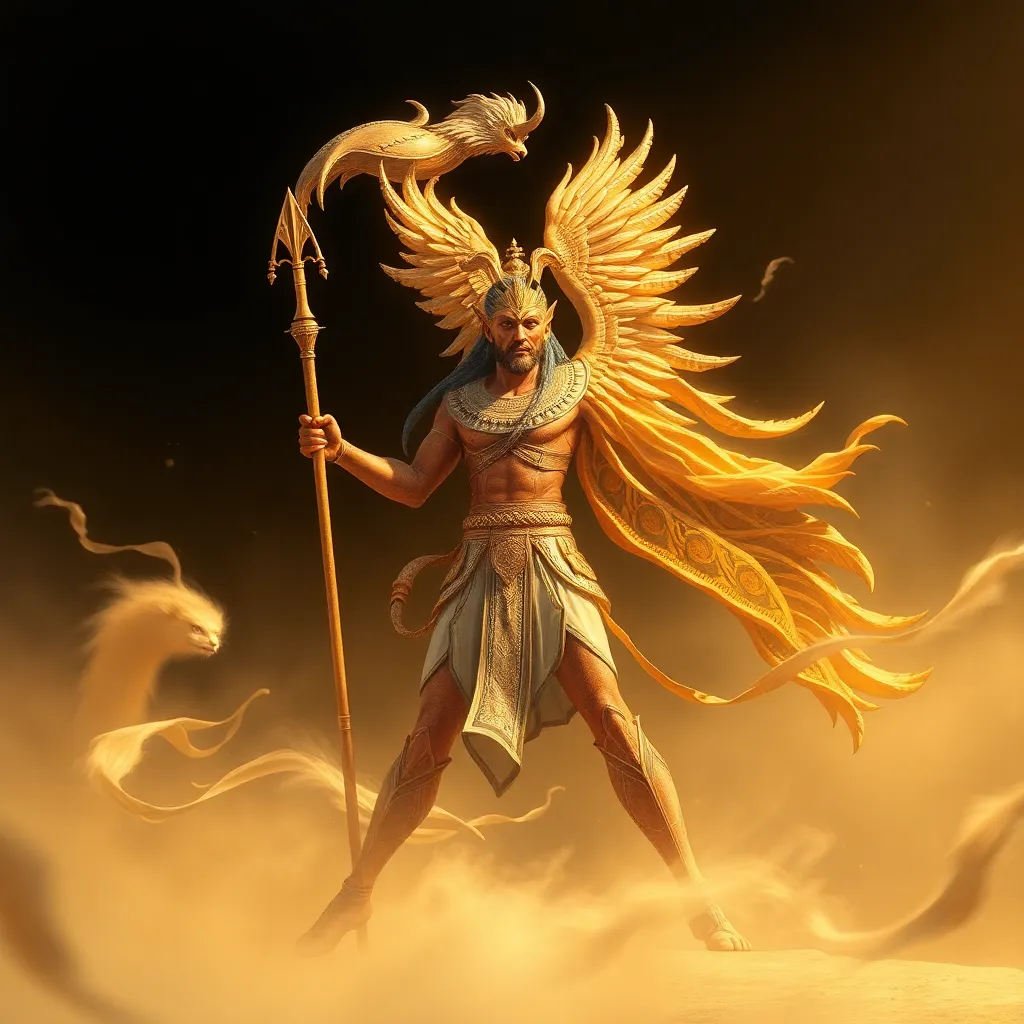The God of the Wind: Shu’s Battle with Set and the Creation of the World
I. Introduction
In Ancient Egyptian mythology, the gods Shu and Set represent two contrasting forces in the universe. Shu, the god of the wind, embodies light, air, and life, while Set, the god of chaos and disorder, signifies darkness and turmoil. The dynamics between these two deities not only reflect the ancient Egyptians’ understanding of their world but also underscore the significance of wind in their culture and cosmology.
Wind was a vital element in the daily lives of the Ancient Egyptians, influencing agriculture, transportation, and religious practices. The interplay between Shu and Set illustrates the balance between order and chaos, highlighting the importance of wind as a force of creation and sustenance.
II. The Deity Shu: God of the Wind
Shu is depicted as a man holding a feather, symbolizing air and lightness. He is often shown with a lioness’s head or a human figure with a plumed crown. As the god of the wind, Shu represents the vital breath of life and the atmosphere that sustains existence.
In the Egyptian pantheon, Shu plays a crucial role as the son of the primordial gods Atum and Tefnut. His siblings include Geb, the earth god, and Nut, the sky goddess. Shu’s responsibilities extend beyond merely being the god of the wind; he is also associated with the concepts of space and order, vital for the creation and maintenance of the cosmos.
III. Set: The God of Chaos and Disorder
Set, often depicted as a man with a curved snout and long, rectangular ears, embodies chaos, confusion, and disorder. He is associated with storms, the desert, and the foreign lands that represented the unknown. Set’s characteristics include aggression, unpredictability, and a tendency towards violence.
The conflict between Shu and Set is emblematic of the battle between order and chaos, with Set often challenging the stability that Shu seeks to uphold. This rivalry is central to many myths surrounding the creation and the maintenance of the world.
IV. The Battle Between Shu and Set
Shu’s confrontation with Set is driven by the need to maintain cosmic order. As Set threatened to disrupt the balance established by the gods, Shu felt compelled to intervene. The motivations behind Shu’s confrontation with Set can be summarized as follows:
- Protection of Nut and Geb: Shu sought to protect his sister Nut (the sky) and brother Geb (the earth) from Set’s chaotic influence.
- Preservation of cosmic order: Shu understood that the stability of the universe depended on maintaining order against Set’s disorder.
- Assertion of his power: The battle allowed Shu to demonstrate his strength as a vital force in the pantheon.
The battle itself is characterized by intense struggles, often depicted in Egyptian art and literature. Shu uses his powers to push back against Set, creating winds that disrupt Set’s plans. This confrontation is not merely a physical battle but also represents the ongoing struggle between light and darkness, life and death, order and chaos.
V. The Creation of the World
Shu’s role in the creation narrative is pivotal, particularly in the separation of Nut and Geb. According to myth, Shu used his powers to lift Nut, the sky goddess, away from Geb, the earth god, allowing space for life to flourish. This act of separation is essential to the creation of the world as it establishes the heavens above and the earth below.
Wind, as Shu’s essence, plays a significant role in this creation process. The gentle breezes symbolize life and growth, while the stronger winds represent the divine force that shapes the landscape and sustains the ecosystem.
VI. The Cultural Importance of Wind in Ancient Egypt
Wind held profound significance in the daily lives of the Ancient Egyptians. Its symbolism can be categorized into several aspects:
- Agriculture: Wind facilitated the flooding of the Nile, which was crucial for crop growth.
- Transportation: The winds powered the sails of boats, essential for trade and travel along the Nile.
- Religious rituals: Wind was often invoked in prayers and offerings, representing the breath of the gods.
In religious beliefs, wind was associated with divine presence and communication. It was believed that the gods used the wind to carry messages to mortals, making it a vital link between the divine and the earthly realms.
VII. Legacy of Shu and the Wind in Ancient Egyptian Society
The influence of Shu and the concept of wind extended beyond mythology into various forms of art, literature, and religious practices. In Egyptian art, Shu is frequently depicted in scenes of creation, emphasizing his role as a life-giver. His image adorned temples and tombs, signifying his importance in the afterlife.
Moreover, wind motifs appear in literature, often symbolizing change, freedom, and the passage of time. The enduring symbol of wind is reflected in modern interpretations of Egyptian mythology, where Shu is celebrated as a figure of balance and harmony within the cosmos.
VIII. Conclusion
In conclusion, Shu’s significance as the god of the wind and his battle with Set encapsulates the ancient Egyptians’ understanding of their world. The conflict between order and chaos, represented by these two deities, illustrates the delicate balance necessary for creation and sustenance.
The importance of wind, both in daily life and in spiritual contexts, highlights its role as a life-giving force. As we reflect on the legacy of Shu, we recognize the lasting impact of the wind in both ancient and contemporary contexts, reminding us of its vital role in the fabric of existence.




